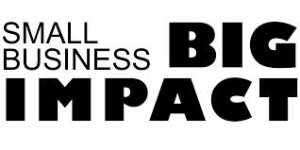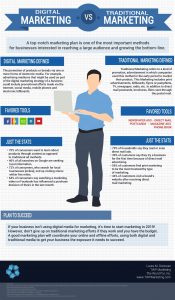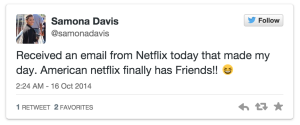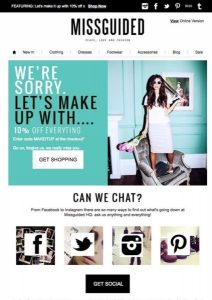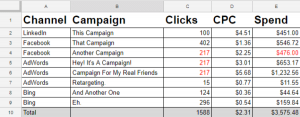The pros and cons of LinkedIn advertising, how much it costs, what ad formats are available and how to set up your first campaign.
LinkedIn is the definitive B2B social network, connecting you with 675+ million professionals around the world. While certain other networks like Facebook and Twitter are highly-capable B2B advertising platforms, LinkedIn is the only major network designed specifically for business minds to connect and engage.
In this guide, we’re going explain the pros and cons of advertising on LinkedIn, explain how much it costs to advertise on the network and show you how to set up your first campaign.
Who should advertise on LinkedIn?
LinkedIn is the most unique social network out of the big players and this makes it relatively easy to decide whether it deserves a place in your advertising strategy. Simply put, if you’re looking for a B2B platform to engage with business decision-makers, LinkedIn is the network for you.
The pros and cons of LinkedIn advertising
LinkedIn pros:
- The definitive B2B platform
- Business-minded user base
- Excellent targeting options
- Allows you to target decision-makers and high-value prospects
- Written content is less demanding than more visual networks
LinkedIn cons:
- High CPCs
- Exporting analytics data isn’t the easiest
- The interface isn’t as intuitive as it should be
Who can you reach on LinkedIn?
According to LinkedIn data, the network has more than 675 million users around the world in 2020. Now, that might not sound so impressive compared to Facebook’s near-2.5 billion users or even Instagram’s 1+ billion user base. However, LinkedIn has the unique advantage of a highly-focused user base that rely on the network for a specific set of purposes – all related to business.
With Facebook, you really have to narrow down your audience to connect with businesses decision-makers, slicing that 2.5 billion user base into smaller fractions. With LinkedIn, you can connect with these people effortlessly, knowing there’s less resistance to marketing messages because this is why everyone’s there in the first place.
LinkedIn users are in business mode and this is a big deal for advertisers.
Here are some more stats from LinkedIn about the kind of people you can reach on the network:
- 75% of LinkedIn members are business decision-makers
- More than 180 million are senior-level influencers
- More than 63 million are key business decision-makers
- More than 10 million are c-level executives
Those are the kind of people you want to reach on a B2B advertising platform.
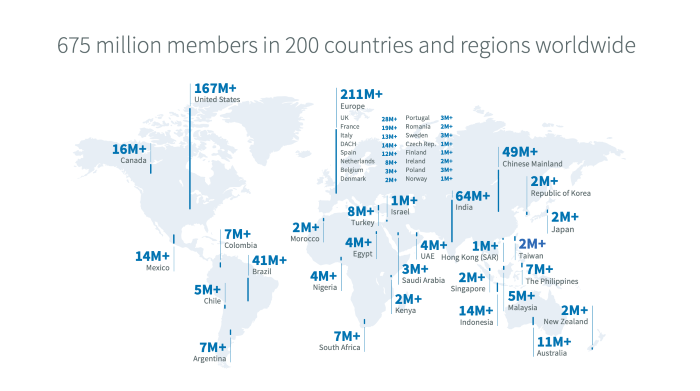
Unsurprisingly, the US has the largest single LinkedIn user base in the world with 167+ million people actively using the network. India comes in second with 64+ million and China has the third-largest user base with 49+ million people.
Then we have the UK, which has the fourth-largest LinkedIn user base, comprising of more than 28 million people.
LinkedIn’s global reach is truly impressive and, to put this into context, there are fewer than three million Facebook users in China where foreign social networks typically struggle to gain traction. Likewise, there are fewer Instagram users in the UK (roughly 24 million) than there are people actively using LinkedIn.
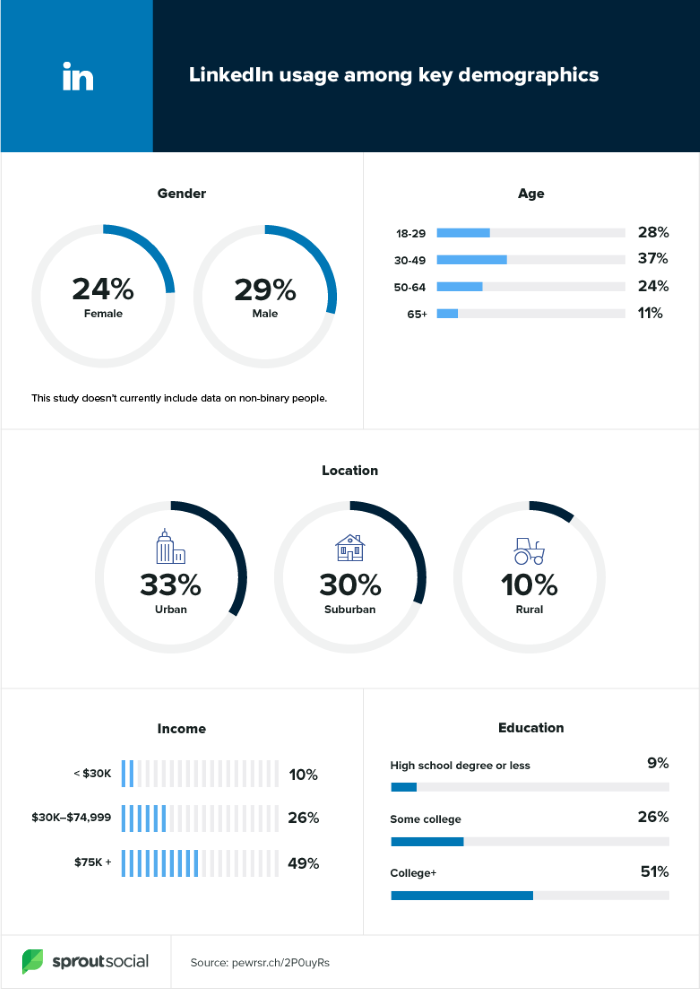
The majority of LinkedIn users are aged 30-49 (37%), followed by 18-29 (28%) and 50-64 (24%). In major economies like the US and the UK, roughly half of users are high-earners with recognised higher education.
To sum up, your key target audience on this network is high-earning, business decision-makers and that sounds great from an advertising perspective.
How much does LinkedIn advertising cost?
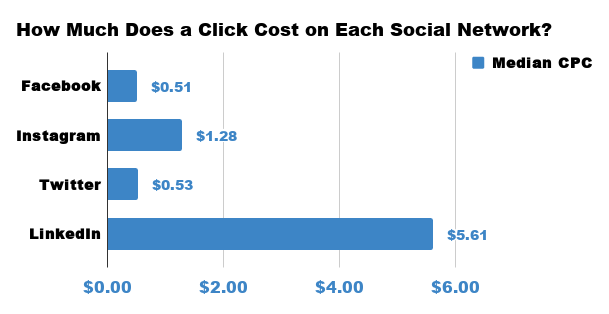
LinkedIn advertising has a reputation for being expensive compared to other networks and, in terms of CPCs, this is generally true. Facebook typically works out as the cheapest option per click.
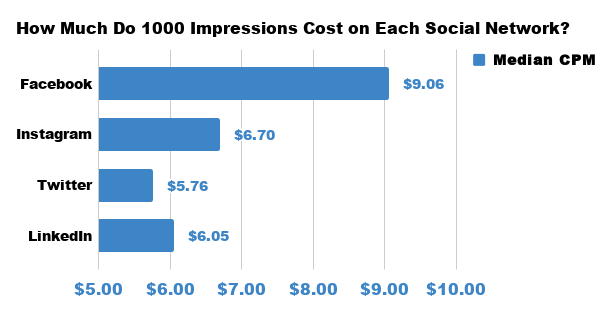
Things look very different if you start comparing median CPM, which gives you an idea of how much you’ll pay to get your ad seen by 1,000 people on each network.
Of course, the true cost varies from one business to another (and one campaign to another) but the fact remains that you’re probably going to pay more for each lead generated via LinkedIn advertising than on other platforms.
What matters with any advertising strategy, though, is the profit your campaigns generate and this is where LinkedIn’s unique user base starts to shine.
As good as Facebooks targeting options are, LinkedIn is simply the more effective platform for reaching specific business decision-makers – the people who are actually going to make purchase choices and sign them off.
This is what makes LinkedIn a special network and higher CPCs aren’t going to be a problem once you start generating leads from the big spenders.
LinkedIn ad formats
There are four main ad types in LinkedIn Advertising, some of which comprise of multiple formats:
- Sponsored Content (Single Image Ads, Video Ads and Carousel Ads)
- Sponsored Messaging (Message Ads and Conversation Ads)
- Text Ads
- Dynamic Ads
You can find more information about these ad types on the LinkedIn advertising website but here’s a summary of what you have to work with.
Sponsored Content
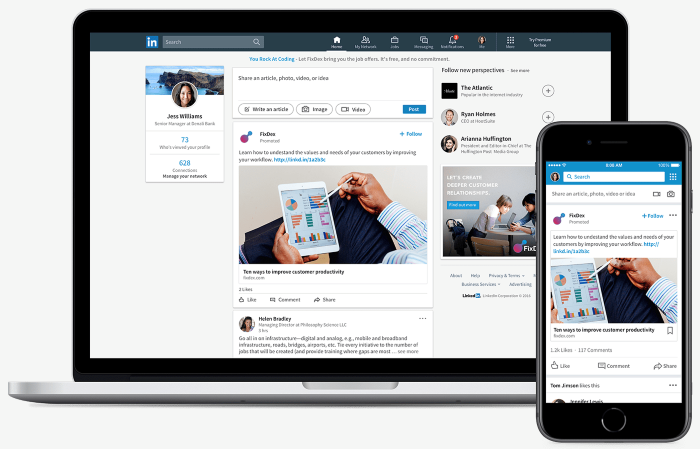
The most common type of ads on LinkedIn are Sponsored Content Ads, which appear in the feed across devices (as you can see above). There are three formats within this ad type, which are designed to engage users on a visual basis, much in the same way we’re used to seeing on networks like Facebook.
- Single Image Ads
- Video Ads
- Carousel Ads
These are native ad formats, meaning they appear in the LinkedIn feed in the same way regular content does, which is good news for click-through rates. You can also turn these clicks into conversions by using LinkedIn Lead Gen Forms on your Sponsored Content campaigns to generate high-quality leads from inside the LinkedIn app.
This is one of LinkedIn advertising’s most powerful features so take the time to get familiar with Lead Gen Forms.
Sponsored Messaging
Sponsored Messaging allows you to reach individual prospects on a personal basis and start meaningful conversations with the people who matter most to your business.
There are two formats within this ad type:
First up, we’ve got Message Ads, which allow you to send direct messages to users with a call-to-action message and CTA to encourage immediate action.
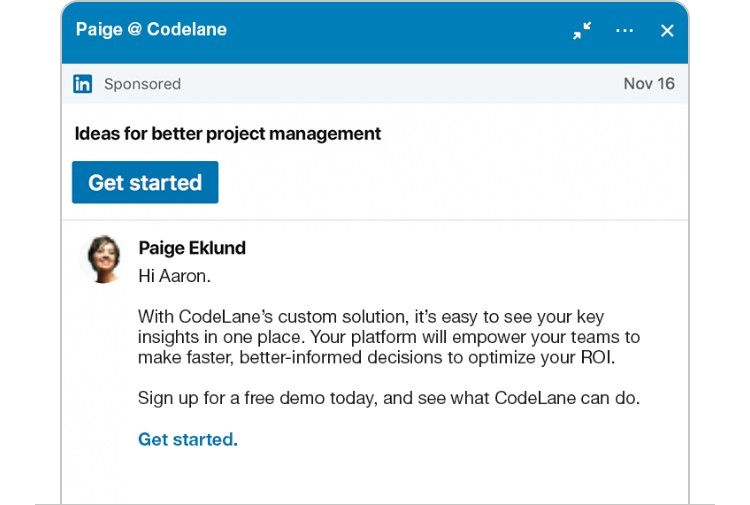
The other format is Conversation Ads, which create a chatbot-like experience designed to engage prospects and guide them through a more complex conversion process.
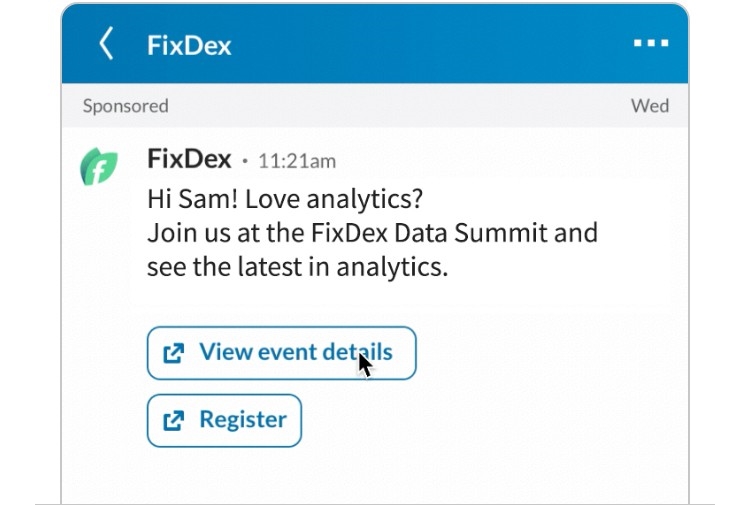
Text Ads
Text Ads are the simplest ad format in LinkedIn, displaying in dedicated ad spots across the platform – eg: in the sidebar for desktop users. Text Ads are also the cheapest ad format to use on the network – both in terms of CPCs and not needing to invest in visual content.
Dynamic Ads
Dynamic Ads are a personalised ad format that reaches out to prospects by their name and uses their account data – such as profile photo, company name and job title – to build quick connections. The ad format places users alongside your brand image to suggest the relationship is already there to nurture and encourages them to follow your brand.
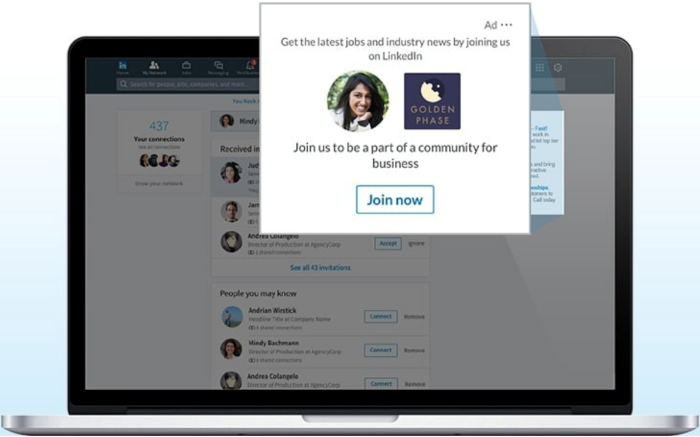
This is a powerful ad format for building brand awareness on LinkedIn.
LinkedIn targeting options
LinkedIn already has a highly-focused user base so it doesn’t need such an advanced targeting system as Facebook to help you narrow down your target audiences. The biggest advantage of this is that you don’t have to spend months getting to know LinkedIn’s targeting options.
Here’s a quick summary of what you can do.
Location targeting
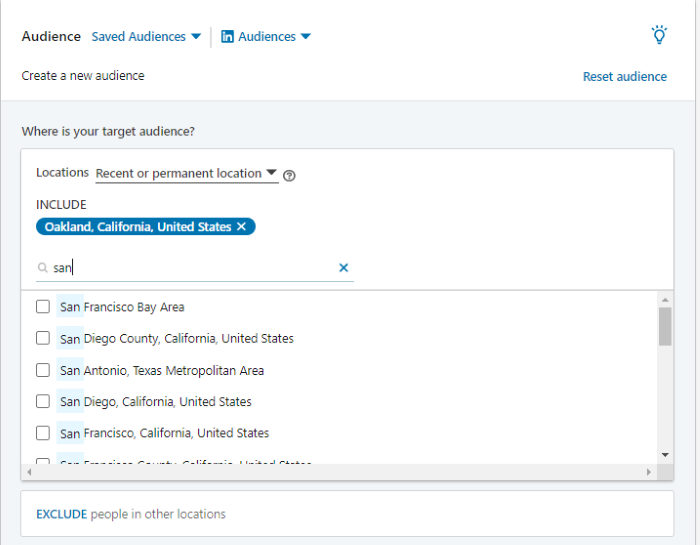
Location targeting is required for all LinkedIn campaigns and this allows you to target audiences based on where they live or where they visit.
You can create a list of all the locations you want to target in the include field and you can also prevent people in specific locations from seeing your ads by adding them to the Exclude field below.
Company targeting
LinkedIn allows you to target users based on detailed information about the company they work for. These are some of the most important targeting options on the platform in terms of pinpointing users who are actually going to do business with you.
- Company Connections: Allows you to reach the 1st-degree connections of employees at companies you select. This is only available for companies with more than 500 employees.
- Company Industry: The primary industry of the company where the member is employed.
- Company Size: Allows you to reach members based on the size of the organisation where they work. Company size is determined by the number of employees listed on the organisation’s LinkedIn Page.
- Company Name: The organisation a member lists as his or her employer. These are based on LinkedIn Pages, which are maintained by company employees.
- Company Followers: Allows you to target your own LinkedIn Page followers. To use this targeting facet, your Ads account must be associated with your LinkedIn Page. When not using this facet, by default your campaigns may reach both followers and non-followers.
To make the most of these targeting options, you really need to do your audience research and determine which kind of companies you want to deal with.
Demographics targeting
Demographics targeting on LinkedIn advertising is really simple. You have the option to target users based on their age and their gender – that’s all there is to it.
Education targeting
LinkedIn lets you be very specific about the educational background of people who see your ads. There are three core targeting options available here:
- Fields of Study: The major or area of study within a member’s degree.
- Member Schools: The school, college, university, or other learning institution where a member completed a course.
- Degrees: Recognised ranks granted by a college, university, or other learning institution.
Of course, these can be useful to companies that want to target current students but you can also use these as an extra layer of targeting to pinpoint the business elite who attended top institutions.
Job experience targeting
Along with company targeting, this is another really important set of targeting options to get familiar with. You want to know your ads are being seen by people who have influence at the businesses they work for – people who influence purchase decisions.
To do this, you need to target people in the right job positions and these targeting options make it possible:
- Job Title: The job title present on users’ profiles.
- Job Function: Kind of like departments – eg: accounting, marketing, product management, etc.
- Job Seniority: Describes the rank and influence of a member’s current role in their organisation.
- Member Skills: Skills listed in the Skills & Endorsements section on user profiles, skills mentioned in their profile text, or inferred skills based on their listed skills.
- Years of Experience: Years of professional experience they’ve accumulated.
Once again, you can layer targeting options and specify any audiences you want to exclude.
Interests and Traits targeting
LinkedIn also provides two types of interest targeting which help you deliver branded and information content to relevant audiences.
- Member Groups: LinkedIn Groups where members who share interests or professional associations can gather, discover new information, and ask questions.
- Member Interests: Interest categories identified by and inferred from member actions and engagement with content on LinkedIn.
You also have the option of using Member Traits targeting, which allows you to reach members based on behaviours, such as frequent contributors or regular travellers, for example.
For more information on LinkedIn targeting options, you can find an in-depth summary on this support page.
Setting up your first LinkedIn campaign
To create your first LinkedIn advertising campaign, sign in to Campaign Manager and select the account you want to use (or create a new one). At the top-right of the main dashboard, click on Create Campaign and you’ll be guided through the following steps.
#1: Choose your objective
First, you’ll need to choose the objective for your campaign from the following three categories:
- Awareness: Select the Brand awareness objective when you simply want to make more people aware of your brand
- Consideration: These objectives are for campaigns that want to target moderate interest in a business like yours.
- Conversions: These objectives are best suited for audiences with a strong intent to do business with your brand.
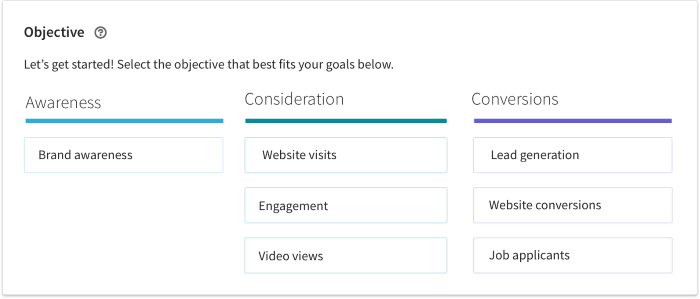
Once you know which of these three goals you’re aiming for, select the objective that matches the user action you want to target – eg: website visits, website conversions, etc.
#2: Define your target audience
Your next job is to define your target audience and you should feel pretty confident about being able to do this after looking at targeting options in the previous section. Again, this all comes down to audience research and the most important targeting settings are normally going to be company and job experience targeting.
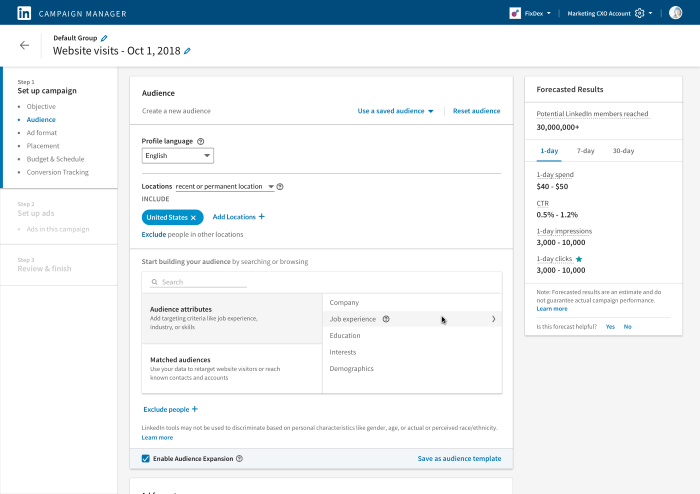
#3: Choose your ad format
Next, you’ll be asked to choose your job format and this where you’ll need to experiment a little. It’s important to choose the right ad format for achieving your campaign objective so if you selected website visits, for example, you need to create an ad that’s going get people clicking through to your site.
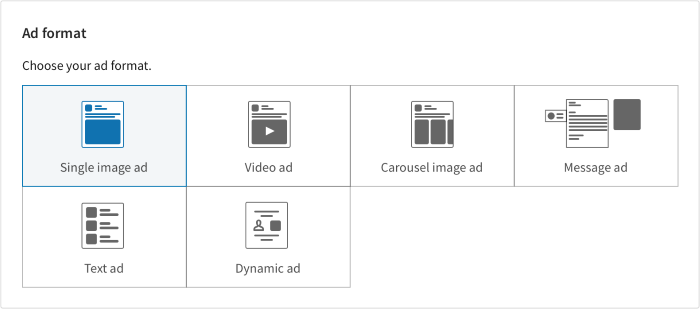
Generally speaking, Sponsored Content formats (Single Image Ads, Video Ads and Carousel Ads) are great options for awareness and consideration campaigns. However, they’re also powerful formats for lead generation, too, if you’re using LinkedIn Lead Gen Forms, as we mentioned earlier.
Dynamic Ads are also great for awareness campaigns but you might want to experiment with these and Message Ads for conversion objectives, too. The increased relevance and personalisation of these ad formats can make a real difference.
#4: Set your budget, schedule and bids
Once you’ve selected your ad format, you’ll be asked to set your budget for the campaign and your maximum bids. First, you want to set your daily budget and be warned that the actual daily spend can be as much as 20% higher than the amount you set – so keep this in mind.
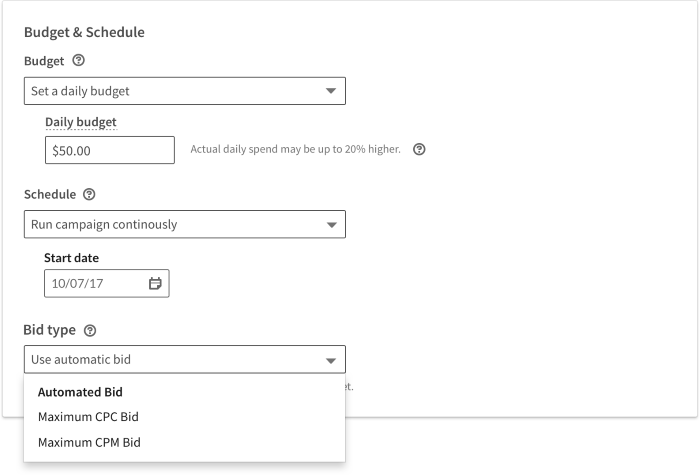
Next up, you have the Schedule section and you can either run your campaign continuously (default) or set specific start and finish dates.
Finally, you’ll want to select your bid type and you can choose from Automated Bid (default), Maximum CPC Bid (cost per click) or Maximum CPM Bid (cost per 1,000 impressions).
#5: Build your ad creative
All that’s left now is to build your ad creative and run your campaign live. The ad builder will guide you through this process and you can find all the ad specifications for things like image sizes and file formats here.
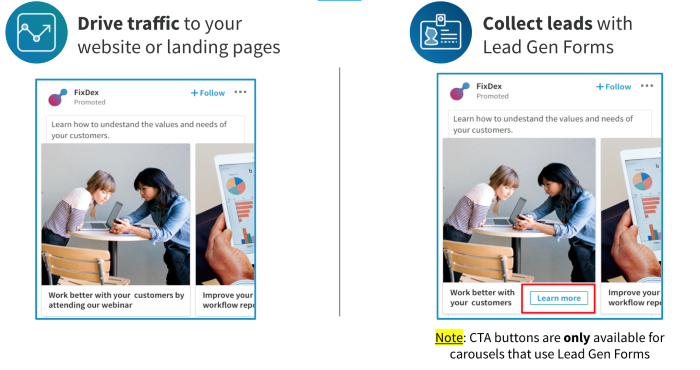
Once you’re done, you’ll just need to confirm your billing information (if you haven’t already) and your campaign will be ready to go.
Is LinkedIn advertising right for you in 2020?
With LinkedIn, this question is really easy to answer. If you want to connect with influential business minds, then absolutely, yes. No other network really matches LinkedIn in this regard, even if the likes of Facebook and Twitter are both capable as B2B marketing tools.
LinkedIn has had its problems in the past but things have improved a lot in recent years and Microsoft deserves credit for a lot of the changes it has made since buying the network in 2017.
Yes, those CPCs might be a little scary at first, especially if you compare them to Facebook, but LinkedIn connects you with high-value business decision-makers and it’s all about the ROI and profit your campaigns generate.
Digital & Social Articles on Business 2 Community
(64)

